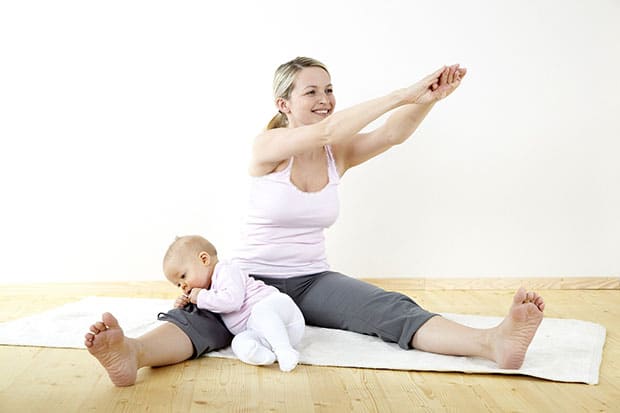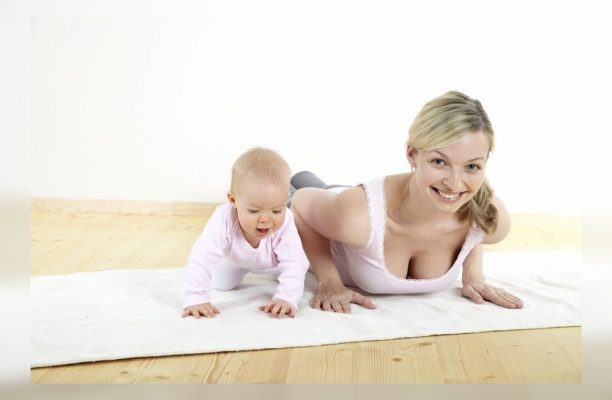How long after giving birth can you exercise?
Physical activity can be returned to your life only after consultation with a gynecologist. If the birth was natural, without ruptures or epizotomy, then sports will be acceptable within a month.
If you had stitches or had a difficult birth, doctors recommend that you refrain from excessive activity until they are completely healed and your body is restored.
A cesarean section shifts the timing of when you can start exercising after childbirth to three or four months.
Does exercise affect lactation?
Some young mothers fear that physical activity will interfere with feeding their baby. Repeated studies on this topic prove that sport does not affect the volume of milk produced.
In 2001, an experiment was conducted. It involved 50 overweight breastfeeding women. They were divided into two groups - some followed the principles of proper nutrition and exercise, others did not.
The experiment lasted 2.5 months. Women involved in sports lost an average of 4-5 kilograms. Mommies from another group - only 900 grams. At the same time, both the first and the second produced a sufficient amount of milk.
These studies give a positive answer to the question of whether it is possible to exercise while breastfeeding.
But a woman should monitor how intensively she loses weight. No more than 2-2.5 kilograms per month is acceptable.
What sports are suitable for a nursing mother?
Excessive physical activity is unacceptable for a nursing woman. This will lead to a decrease in lactation. There is a high risk of exhaustion if efforts with a child are supplemented by intense training.
What sport is suitable for a nursing mother:
- An excellent option is fitness for nursing mothers . You will strengthen your muscles and increase your vitality. Regular exercise will help you lose extra pounds.
- Pilates will strengthen the muscles of the pelvis and abdomen. Other muscles will also become stronger, including the back. In this case, the exercises are aimed at static loads, which allows you to effectively lose weight.
- Yoga will help tone all muscle groups and strengthen your back. Training has a beneficial effect on the nervous system, sleep and emotional state improves.
- Walking is a good way to lose weight and increase vitality. This is the most accessible sport for a nursing woman. After all, she can combine it with walks with the child.
- Gymnastics. Simple exercises and bending can strengthen the muscles of the back, abdomen, chest, hips, and increase vitality.
- Cycling will strengthen your leg muscles, speed up your metabolism, and help you lose weight.
- Skiing is a great option for winter. You will increase your vitality and strengthen the main muscle groups.
- Swimming while breastfeeding is also allowed. Swimming has a beneficial effect on the back and promotes weight loss.
- Water aerobics classes are also acceptable.
The benefits and harms of sports during lactation
Recently, information has spread that exercise leads to the production of lactic acid. It penetrates into mother's milk changing its taste. The result of the changes is the baby’s refusal to take it. Scientists who conducted many experiments undertook to dispel the information. The results consoled the women. Exercises do not have a negative effect on lactation, the taste of milk remains the same.
The only important point that should not be overlooked is injured breasts. Comfortable underwear that does not restrict movement, but holds the breasts well during exercise, is selected correctly. During breastfeeding, sports should bring positive emotions.
Sports exercises during breastfeeding have many positive qualities, the most striking are:
- An important thing for a young mother is that physical education is a variety of daily care for the baby. The time when a woman takes care of herself.
- Exercises allow you to restore your previous figure and improve it. Removing belly fat is more difficult; regular exercise will be required; it is additionally recommended to visit a massage room.
- By visiting the gym you can throw out accumulated emotions.
- Physical activity of various kinds is beneficial for the body. The cardiovascular, musculoskeletal, and respiratory systems are strengthened. The condition of the body as a whole improves and immunity increases.
If you don’t have time to go to the gym, you can actually do physical exercises at home. It is important to understand that sports during breastfeeding benefits a woman, her physical appearance, and mental state.
We recommend reading: Mother’s temperature during breastfeeding: how and with what to reduce the fever during breastfeeding?
What sports should you give up?
Strength training is generally prohibited. Because they are energy-consuming. Which can lead to decreased milk production. Plus, there is a high risk of sutures coming apart or uterine bleeding.
Boxing, wrestling and other contact sports are also not suitable. There is a high risk of chest injury.
Often nursing mothers wonder if they can run. Intense jogging is not recommended. With them, the breasts “are in motion,” which leads to a decrease in lactation.
Step, aerobics, and all exercises based on shock loads and jumping are not suitable for the breastfeeding period.
The reason is that the body expends a large amount of energy, which negatively affects lactation. Also, the breasts constantly fluctuate, which is unacceptable.
Sports after childbirth: pros and cons
There is an opinion that physical activity and breastfeeding are incompatible things. But, according to doctors, it is not justified and even erroneous. Moreover, what matters here is not the sport itself, but its type and intensity of physical training. In other words, if they are of a healing nature and do not take up to 8 hours a day, then why not?

In addition, light exercises on the chest muscles help improve lactation. We are talking about swinging movements or rotation of the arms and shoulders. The main thing is to make sure that they do not create tension, but a warming effect. This will ensure blood flow to the breast muscles, and with it the milk itself.
Experts highlight other benefits of physical activity for a nursing mother:
- they help her get back into shape faster;
- improve mood due to the release of endorphins into the blood;
- help relieve tension;
- allow you to improve the shape of your breasts and quickly return to your previous weight;
- promote the production of prolactin, which directly affects lactation;
- help relieve pain in the neck, spine, back and shoulder blades caused by prolonged carrying of the baby in your arms or rocking him to sleep.
But overexertion and breastfeeding are incompatible concepts.
Since in this case lactic acid is released into the blood. People say that it can change the taste of milk in such a way that the baby will refuse it. Doctors adhere to the scientific point of view, according to which exhausting training will lead to overwork, as a result of which its amount will decrease.
Recommendations for organizing classes
For a nursing mother, classes lasting from half an hour to an hour are suitable. It is better to train every other day. If you are ready for daily exercise, alternate muscle groups and shorten your workouts to 40 minutes.
The first workouts should be no more than 20-30 minutes. It is optimal to start with twice a week.
During classes, adhere to the following rules:
- Stay hydrated. Drink lightly during your workout. If you devote an hour to sports, you need to drink up to a liter of water.
- After training, dried fruit compotes and herbal teas will help restore strength.
- Protect your chest from bruises. They lead to stagnation of milk and inflammation.
- Choose a sport that will bring you pleasure; a positive attitude and good mood are important when breastfeeding.
- There is no need to try to squeeze the maximum out of yourself. After your workout, you should feel slightly tired.
- Alternate exercises aimed at strengthening or “drying” muscles with relaxing ones.
- Avoid straining your chest muscles (push-ups).
How to exercise correctly
Fitness and breastfeeding are quite compatible if you follow some rules in your exercise:
- Do not use exercises for the chest muscles. This can disrupt lactation, cause pain and discomfort, and provoke inflammation in the tissues of the mammary glands. You should also avoid exercises that cause your chest to fluctuate greatly, that is, running, high jumping, in a word, athletics.
- Don't push yourself to the point of exhaustion. The load needs to be increased progressively, remembering that the exercises should refresh and give tone, and not lead to fainting. This can lead to loss of milk.
- Eat properly. The desire to lose excess weight should not prompt a young mother to starve. This will inevitably harm milk production, general well-being and the condition of the mammary glands.
- Maintain hygiene. Fitness while breastfeeding should not result in sweat remaining on the skin for too long. This is important to prevent inflammation in the mammary glands, which can become an obstacle to feeding.
- You can choose a sport to your liking only from activities that require measured movements. This is walking, swimming, yoga, fitness. They are equally useful for milk production, for giving elasticity to muscles, and for restoring normal weight. Heavy lifting is excluded.
- If possible, start classes under the supervision of an instructor, choose the right time for them (preferably immediately after feeding or 1.5-2 hours before it). Then you will definitely be able to avoid changing the taste of the milk.
We recommend reading the article about visiting a solarium while breastfeeding. What benefits or harm a solarium can bring, how exposure to ultraviolet radiation affects a woman’s body during lactation, what precautions you need to take in a solarium, you can read in more detail in this article.
Joint activities with the baby
Often nursing mothers are unable to play sports because they have no one to leave their baby with. And I don’t have enough motivation to workout at home.

For the past 3-5 years, fitness centers have been offering a variety of co-op classes. They solve the problem of lack of a nanny and help to establish a closer connection between mother and baby.
- Swimming. Joint activities in the pool will be useful for both the child and mother. They will prevent increased tone in the baby and strengthen the nervous system.
- Slingo dancing. New directions in joint activities for nursing mothers. If you are one of those parents who will not part with a sling or ergo backpack, these are for you. Exercises include elements of yoga, Pilates, and dancing.
- Fitness is the most popular and widespread type of joint sport for a nursing woman and baby. Exercises for a mother with a baby can help you lose weight and strengthen muscles. They are simple and you can do them yourself at home.
- Yoga centers also offer classes for new mothers and their babies. You can start practicing them three months after giving birth.
How to tighten your belly while breastfeeding
The most problematic area of a woman's body after childbirth is the stomach. The fat layer and flabby muscles make it saggy.
Most young mothers have a desire to get themselves in order. The first thing that comes to mind is abdominal strengthening exercises.
But immediately after childbirth they are prohibited. You can start exercising after a scheduled visit to the gynecologist and with his permission. Usually you have to wait two or three months. After a cesarean section it takes longer, sometimes up to six months.
You need to start pumping up your abs while breastfeeding with light loads. Two or three sets of five times. The break between sets is two minutes.
It is important to do exercises for both the “upper” and “lower” muscle groups. In the first case, the body is raised, in the second - the legs. They are held at an angle of 45° or 30°.
You can use a fitball. It is suitable for strengthening the abdominal and back muscles.
Don't forget about a light warm-up before training. You can do bends, swings with your arms and legs, and squats. You can complete your workout with stretching exercises if you wish.
Sports for young mothers
As for direct sports activities. It is advisable for women who are breastfeeding to refrain from exercising during the entire feeding period. Those who have stitches after a rupture or cesarean section are not recommended to exercise for the first six months after giving birth. Are you feeling great and can’t wait to take care of your figure? Experts advise first undergoing a routine ultrasound of the abdominal cavity, which is done in the second month after childbirth, and only then start playing sports. If the gynecologist does not reveal any problems with your health during the examination, you can safely run to the gym.
Sport should be moderate. Remember that a new mother should not lift more weight than her baby. Any load can affect lactation or the body's recovery process. The first signal to give up fitness may be:
- Decreased milk production at night.
- Spotting bloody discharge.
- Pain in the groin area.
- Pain in the area of stitches after cesarean section.
- Increased sleepiness.
The intensity of training for weight loss is chosen by the woman herself, focusing on her own well-being. Although there are recommendations - no more than one hour once a day. Breathing exercises are suitable for breastfeeding women and women who have had a caesarean section. I will give examples of such exercises at the end of the article. The best time to practice while breastfeeding is between nine and eleven in the morning. This is the baby's time to rest from morning feeding, and before lunch there is still time to take a shower and eat. It is important to consider that milk is formed within thirty minutes after eating. As I already said, overwork is fraught with consequences. You need to start small. For the first time, five minutes of light exercise will be enough, which can include: squats ten times, abdominal exercises fifteen times. Increase the load by one and a half times. If you feel that you are getting sick, do not stop suddenly! Calmly reduce the load, moving on to swinging your arms and restoring your breathing. If reducing the load does not help and you feel acute pain in the abdominal cavity after training, consult a doctor.
Ten popular exercises for losing weight after childbirth
This article will discuss the most popular exercises for losing weight after childbirth. I would like to note that not all of the above exercises are allowed for women who are breastfeeding or have had a cesarean section. To avoid getting lost in the text, pay attention to the pictures that show how to perform each of the exercises...
Walking
Many athletes say that walking for half an hour is much more effective than jogging for two hours. However, not everyone knows that only by following the correct walking technique can you achieve the desired effect. The essence of race walking is foot placement. The foot should fully touch the ground. The steps are small and fast. While walking, tense your gluteal and abdominal muscles.
Half bridge
This is a simple but very effective exercise. When doing it, you strengthen the back of your legs and buttock muscles. You can start by lying on your back. Bend your knees and place your hands behind your head. Raise the pelvis. As you lift your lower back off the floor, pay attention to your shoulders and back. It is important to form a straight line between your legs and chest. Returning to the starting position, strain your buttocks and abs as much as possible. This exercise can be performed with a child, as shown in the figure.
I consider this exercise to be one of the most effective for giving our buttocks some piquancy.
When I started studying, I set myself a small load. I started with ten approaches. Every three days I increased the number of approaches by five. So, gradually, I began to perform sixty approaches at a time. Try to fix your body while lifting and hold for one minute.
Triceps swing
For breastfeeding women, exercises that place stress on the chest and arms are prohibited. Such exercises can have a significant impact on milk production. Therefore, triceps swings are suitable only for those mothers whose babies are bottle-fed.
When starting your workout, take your pulse. It is necessary to monitor the condition of your body. Overvoltage must not be allowed. Therefore, watch your breathing (as you exhale, lower your hand, while exhaling, push the dumbbell up).
Sit on a chair, rest your shoulder blades on its back. Hold the dumbbells with your palm facing your face. Raise your arm from the dumbbells, holding your elbow with your free hand. The elbow should not fall forward. Do ten flexions and extensions. Change hands and repeat the exercise.
To begin with, you can do three approaches. Over time, increase the load until you reach thirty sets.
Jumping rope
Jumping rope is very beneficial for human health. Thanks to them, the respiratory system is trained and blood pressure is normalized. They help strengthen the heart muscles and blood vessel walls. In addition, in terms of calorie consumption, jumping rope is not inferior to swimming or running. You need to start jumping rope with a light load - five minutes a day. After a week of such exercises, you can increase the training time until you reach thirty minutes. If you feel unwell, gradually reduce the rhythm. And then reduce the load level.
Press swing
For a tummy tuck, systematically repeated abdominal pumping is suitable. Lie down on the mat, put your hands behind your head, bend your knees. It is important that your elbows are directed to the side and not pressed against your head. Hands cannot be clasped. As you exhale, bend your body forward, straining your lower abdomen. We repeat the exercise twenty-five times. The average time for this exercise is one and a half to two minutes.
On topic: Exercises for the lower pectoral muscles for men
Squats
The squat is the basic exercise of any workout. With the help of squats, you can perfectly work out the muscles of the legs and buttocks. In any weight loss program, women are advised to perform squats at least thirty times. Only proper execution of squats will provide a significant load. Squat down as deeply as possible. Jump up without lifting your feet off the ground. Repeat this exercise ten times, three sets each.
The effectiveness of this exercise is that you can easily work the front and back of the thigh, large and medium muscles of the buttocks.
Starting position: rest on your elbows and knees. The back is straight, the lower back does not sag. We look forward, there is no need to lift our necks. We start with the right foot. Straighten your leg back and place your foot on your toes. Raise your straight leg, trying to reach up with your heel. Make sure your back is fixed in one position. Lower your leg and repeat the desired movement ten times.
Dumbbell press
Stand up straight and grab dumbbells. The arms are bent at the elbows (see picture). As you exhale, lift the dumbbell, and as you inhale, lower it. Do this five times. Doubling the load every week. While performing the exercise, watch your posture. The hand should not fall back.
This exercise should absolutely not be performed by breastfeeding women.
As I mentioned above, during lactation the load on the chest should be minimal. To avoid sagging breasts, wear special bras for nursing women. It's even better to sleep in it. After childbirth, it is important to monitor your breasts. Milk stagnation should not be allowed. To avoid “expanding” of the breast, you can attach the baby more often or hold it back a little. You need to stop feeding gradually - cancel feedings one after another until there is only one left. In the end, slowly give it up too.
Others should also avoid this exercise for the first seven months after giving birth.
Plank
The plank is an effective exercise for maintaining all the muscles of the body in good shape.
The point of doing this exercise is to “freeze” above the floor in the correct position for one minute. Support should only be on your hands and toes. While performing the exercise, try to tense your abdominal and buttock muscles as much as possible. Avoid bending; your back should be straight for the entire minute.
Lunges
Stand up straight. Hands on the belt. Feet shoulder width apart. We start with the right foot. As you exhale, we take a step forward with an extension. As you inhale, we return to the starting position. After completing 10 lunges, we change legs. Now do the same starting with the left leg. Watch your posture. Do not slouch or hunch while performing the exercise.
Effective exercises for weight loss

If you can’t go to the gym, you can train at home. You can exercise every other day, for 20-30 minutes.
The following weight loss exercises are effective for breastfeeding women.
Exercise 1
To strengthen the abs and gluteal muscles:
- lie on your back, arms along your body;
- lift your legs and shoulder girdle at the same time;
- try to hold this position for three seconds;
- do three sets of 8-10 times each.
Exercise 2
You can strengthen your abs as follows:
- sit cross-legged, if possible, take the lotus position;
- straighten your back, cross your arms over your chest;
- make rotating movements with your body.
Exercise 3
For buttocks, back and abs:
- lie on your back;
- bend your legs at the knees;
- place your feet on the floor;
- spread your legs shoulder-width apart;
- extend your arms along your body;
- lift your buttocks and pelvis, stay in this position for as long as possible (at least 5 seconds).
- perform three sets of 8-10 times, break between sets – 30 seconds.
Moderate physical activity is allowed while breastfeeding. They will help not only get your body in shape, but also improve your mood and increase your vitality.
Exercises
Think over a training program for yourself, what activities should be included in the complex. Don't choose moves that are too difficult. A few basic techniques will be enough to achieve visible results in just a couple of months. Recommended components of training for nursing include a number of methods aimed at restoring the figure:
- Charger. It's best to start the day with exercise. Five minutes of light exercise will charge you with energy, give you a feeling of lightness, wake up your body, and tone your muscles. Stretch, squat, swing your legs and arms.
- Abdominal exercises. The famous crunches strengthen the abdominal wall, which needs to regain its elasticity after pregnancy and childbirth. It is important to pump up your abs correctly. To perform this, you need to lie on the floor, fix your legs, hands behind your head, and your back is rounded. Raise your body to your feet, don’t forget to breathe correctly. Perform 2-3 sets of 12-15 reps.
- Breathing techniques. It has been proven that oxygen oxidizes fat cells and dissolves them. Therefore, proper breathing promotes weight loss. Popular oxygen-saturating techniques include bodyflex, oxysize, jianfei, etc.
- Squats. Buttocks and legs are problem areas for women due to the physiological characteristics of their body structure. You can remove extra centimeters using squats. To do this, grab the support with your hand and place your feet shoulder-width apart. You need to squat until your pelvis reaches a position parallel to the floor. We don’t bend our back. We do 2 sets of 20 times.
- Swing your arms. The classic “mill” exercise perfectly strengthens the muscles of the back, arms and chest, tones the muscles, and accelerates the blood. Stand straight, feet slightly wider than shoulder height, arms at your sides. When bending over, try to touch the toe of your left foot with your right hand, and your right lower limb with your left hand. We perform swings one by one, creating the effect of a mill.
On the topic: At what angle to pump the pecs
You need to train 2-3 times a week. Do not overuse physical activity and do not exhaust yourself. The body and muscle fibers need time to recover, so short breaks will be beneficial.











